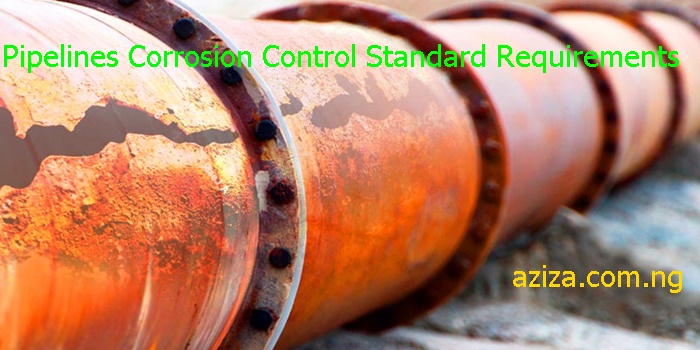In this post, we covered what Pipeline Corrosion means, the minimum requirements and the procedure for cathodic protection of ferrous pipe and its components from internal and external corrosion the design of which shall generally follow the specifications and procedures prescribed in NACE SP0169-2013, API RP1160-2019 and other internationally recognised standards approved by NUPRC for managing pipeline system integrity in Nigeria. You can contact Aziza M.E.S Limited for your Pipelines Corrosion Control Services.
What is Pipeline Corrosion?
Pipeline corrosion can simply be defined as naturally and continuous damage caused to pipeline by corrosion. It refers to the degradation and destruction of metal materials caused by chemical and electrochemical interactions between metal materials and environmental media. It can have a negative impact on the integrity and longevity of the pipeline. Pipe materials affected by corrosion include metal and non-metal pipes, pipe joints, welds and surface coatings. The corrosion can occur on both internal and external of the pipes. Therefore, anti-corrosion is the primary problem to be considered in pipeline. So how to avoid it?
Read: Pipeline Design, Construction and Operation Guidelines
External Corrosion Control of Buried or Submerged Pipeline
This shall consist of application of coating to the pipeline and its cathodic protection to achieve the following objectives:
A. Protective Coating
- Shall be applied in such a way that it will mitigate corrosion and adhere to the pipe metal surface sufficiently enough such that it will effectively resist under film migration.
- Shall be ductile and strong enough to resists cracking and damage during handling and under soil stress.
- Shall be compatible with any supplemental cathodic protection and if is an insulating type material shall have low moisture absorption.
- Shall be applied in such a way that no irregularities protrude through it and no holiday gaps exist in the coating all along the whole length of the pipeline.
- The points of connection of any attachment to pipeline shall be equally sealed with the coating, together with the attachments themselves.
B. Cathodic Protection System
- This shall be provided by either a galvanic anode or impressed current anode system installed in such a way that it mitigates corrosion and contains method of determining the degree of cathodic protection achieved on the pipeline. The criteria for the selection of an appropriate protection system shall be as listed in NACE SP0169-2013 and relevant subsequent provision, including other internationally recognised standards approved by NUPRC.
- The system shall be installed not later than one year after the laying of the pipeline in such a way that the pipe coating at the points of installation is kept intact.
- The cathodic protection system shall be electrically isolated at all inter-connections to other pipeline systems or structures except where the two structures are mutually protected by the same system.
- The cathodic system shall be protected against damage by atmospheric electrical discharges, underground cables and power lines.
Read: Pipeline Systems Licences/ Permits Processing Fees
- Except for underwater pipelines, sufficient test leads shall be installed on buried pipelines for occasional check of the effectiveness of the cathodic protection to be carried out by electrical measurements. Such test stations shall include all pipe casing installations, insulating joints, all crossings and main manifold junctions.
- A minimum separation of 3 meters shall be maintained between electric transmission tower footings, ground cables and earthing, power lines and the pipelines under protection.
Internal Pipeline Corrosion Control Requirements
- The general rule shall be the avoidance of transportation of any corrosive materials in a pipeline without appropriate measure taken to mitigate the corrosion effect of the commodity on the internal section of the pipeline.
- Internal corrosion shall be prevented either by frequent pigging, inhibiting, scraping or application of internal coating on the pipeline before laying.
- Whichever method is used, appropriate precautions shall be taken, such as the utilization of sufficient coupon holders when inhibitors are used and the compliance with established industry standards of internal coating materials.
Read: Pipeline Construction & Maintenance Services
Pipeline Corrosion Treatment
Chemical treatment is the main solution for many internal pipeline corrosion problems. Washing the pipe by chemical solutions pumping clears away any corrosion product. Coating and protection of the lining of the pipe by pumping chemicals is next in the process. For external treatment re-coating is the most common, tried and tested treatment. The same treatment applied to any corroded metal. The rust and coorrosion is cleaned from the metal. The pipe is then coated with a specially designed coating to protect it.
Ways to Do to Avoid Pipeline Corrosion
Preventing corrosion requires elimination or suppression using two principal methods, cathodic protection and anti-orrosion coatings. Generally, cathodic protection systems are used in conjunction with coating systems.


